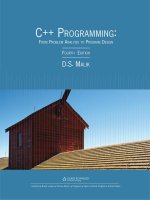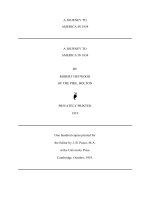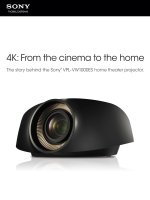From Print Design to Web Design "Using Smalltalk to Connect both Worlds" pot
Bạn đang xem bản rút gọn của tài liệu. Xem và tải ngay bản đầy đủ của tài liệu tại đây (16.43 MB, 27 trang )
1
Georg Heeg eK
Baroper Str. 337
44227 Dortmund
Germany
Tel: +49-231-97599-0
Fax: +49-231-97599-20
Email:
Georg Heeg AG
Seestraße 131
8027 Zürich
Switzerland
Tel: +41(848) 43 34 24
Georg Heeg eK
Wallstraße 22
06366 Köthen
Germany
Tel: +49-3496-214 328
Fax: +49-3496-214 712
2
From Print Design to Web Design
"Using Smalltalk to Connect both Worlds"
Georg Heeg eK 2009
Author: Roland Wagener
3
From Print Design to Web Design
1. What's the Problem?
2. So, lets build a bridge!
3. Now, lets build a product!
4. It currently looks like this
4
What's the Problem?
Designers are artists with
a special language
They are thinking in
colors
colors, fonts and perfect images
Asthetics and good taste
are key to their success
look at the results:
– Brochures, Flyers, Posters, Magazines
5
We love to look at Them!
But we look at paper, if we adore those
results Most of the time
On the web, we find those gems ransformed
into PDF documents or Flash booklets
So why is it that we don't look at
some beautiful normal
HTML-based web pages?
6
What Tools do they use?
Photoshop, Illustrator, Freehand
Pagemaker, Quark-Express, InDesign
– They are all mainly targeting at print
oriented output
– None of them can export a web page
• Ok, Photoshop can export an album site,
but that's something different
7
ADOBE supports you
8
Designing for the Web?
HTML
Flash
9
Designing for the Web II
designers export graphic versions of
their documents to web programmers
The images are decomposed and
arranged on a web page
The results differ from the original
10
Designing for the Web III
HTML and its limitations are exposed to the
user and influence the design a lot
– Can't use all fonts
– Shouldn't use all colors
– Images squeezed and compressed
– Positioning can be fun
– Learn CSS and you will win
A nightmare for a professional designer
11
So what options do they have?
InDesign
©
exports into two web compatible formats:
PDF and Flash
– The whole layout is preserved
– It is a one-click operation
– no tuning of the result necessary
But end users are not always fond of
PDF and Flash
12
PDF/Flash versus HTML
PDF or Flash
– Proprietary file format
– Needs a browser plug-
in
• Plug-ins consume
additional plattform
performance
– Large files, all pages
are fetched in one go
• Long download times
– May include fonts not
available on the clients
computer
– Flash cannot embedd
flash
HTML
– The web file format
– All browsers support it
• They are optimized for
this
– Each page is separate
• Shorter load times per
page
– Simple to interface
with other web sites
and web applications
– Flash and other media
can be embedded
13
So, lets build a bridge!
Objectives:
– designer can stay with the tools he knows well
– No need to learn HTML or CSS
– export of designer documents to HTML format
Like this!
14
How did VisualWorks help us?
Based on exports of InDesign CS4
– We used the XML frameworks, and build domain objects
for each InDesign-page
– various image operations are done using an external
library to create PNG files
– With
seaBreeze
seaBreeze providing a complete HTML object
model, we were able to build a seaBreeze page for each
InDesign page
• The first prototype was shown to a customer
after about two weeks
15
Image processing I
We started using InkScape,
an SVG based vector graphics application
– Called from the command line
– Available on all platforms (Win, Mac, Linux)
– InkScape converts SVG into PNG files
– />16
Image processing II
This approach was very expensive
– Starting up InkScape 100 to 1000 times for a
conversion took too long
– The command line call did not allow us to
re-use a running InkScape
And InkScape 0.46 created wrong images in
certain complex transparency situations
17
Image Processing III
An alternative was Batik, a Java SVG toolkit
– We used JNIPort by Chris Uppall and
Joachim Geidel to call it from VisualWorks
– The performance improved dramatically
• Java starts up just once,
• subsequent calls are just very fast
– Also available on all platforms
– />18
To have or Not to have
A designer uses Fonts to attract attention
Fonts are key to his work
HTML does not allow to make use of fonts
reliably
– If a font is missing on the client machine, the
text will be displayed a default one, like
Times, Courier or Helvetica
How can we help?
19
Display of Text
export text as vector paths
– This way, the font is used on the designers
computer
– The client doesn't know about the font at all
However, text exported this way will
become a PNG image in the web
– we are able to attach the original text to the
page, but it is not the same
– The user has the choice here:
• Content or Design
20
The Prototype
A web application written in seaBreeze
Our idea was to deploy the converter as a
web based service
– Pay-per-conversion
– Pay-per-converted page
– Pay-per project
But users wanted a 'real' application, or
even an InDesign Plug-In
21
Now, lets build a product
From an engineering point of view
'We are finished, we can do it!'
From a customer point of view, the solution of the
converter as a web service was not acceptable!
– No platform integration
– No integration into InDesign
– No internationalization
A standalone MacOSX application is the next goal
– Designers love the Mac
– And the simpicity of usage
22
And so, we are in the process of
Preparing a MacOSX application
– Interface to the Application Menu
– Support the platform help system
– Support drag&drop of files
– Open the browser on the resulting HTML
pages
– Inventing icons and herald screens
– Writing marketing material
– Find a pricing model
–
23
Interface to the Mac-Menu
Use the InterfaceBuilder
and modify the original
MainMenu.nib inside the
visual.app/Contents/Resources
folder, and put
translated versions into
the language project
folders
Use unique MenuItem-IDs
but do not change the
existing ones!
24
Two facets of Internationalization
The Mac has one for
Resources
– Apple-Help is
organized this way
And VisualWorks has
another one for
MessageCatalogs
– UIs based on
UserMessages can use
them, the interface to
the location inside
the .app-folder is via
manual modifications
25
It currently looks like this









